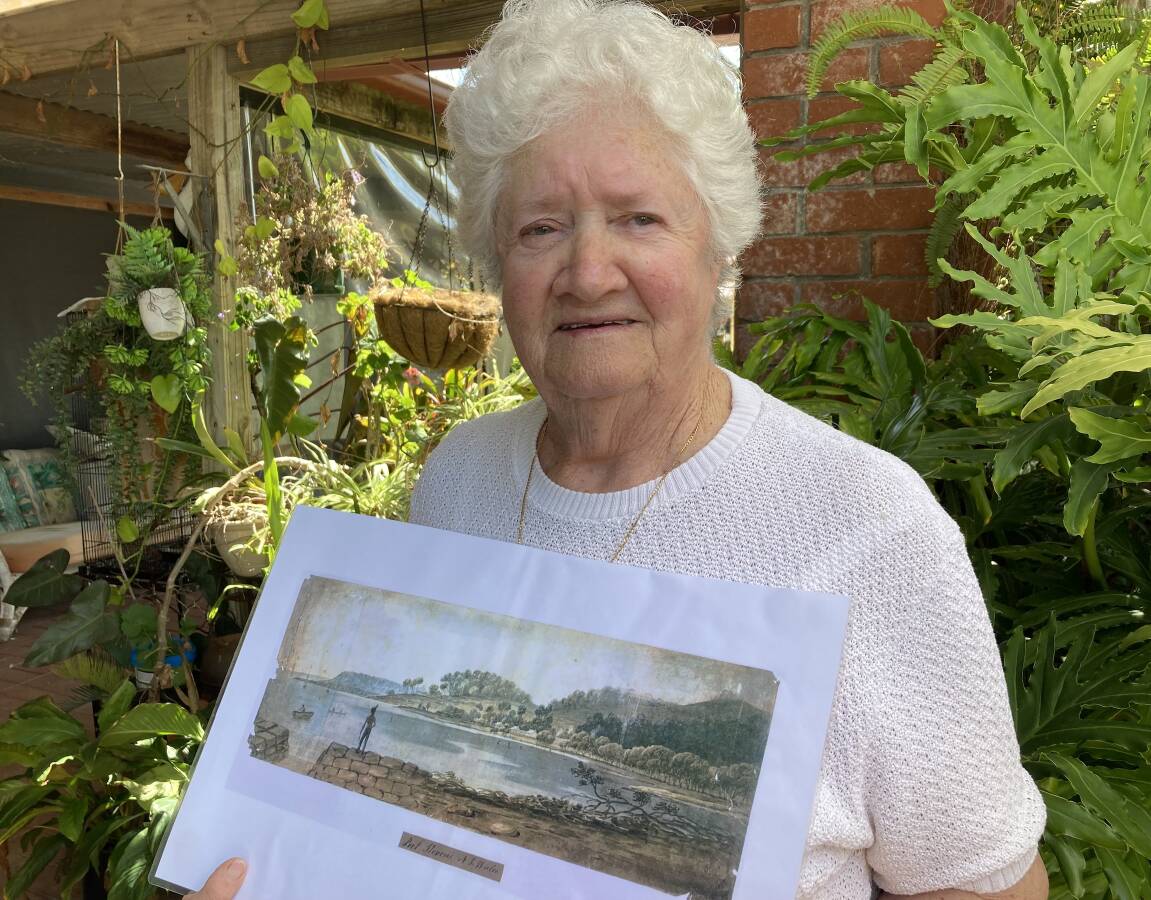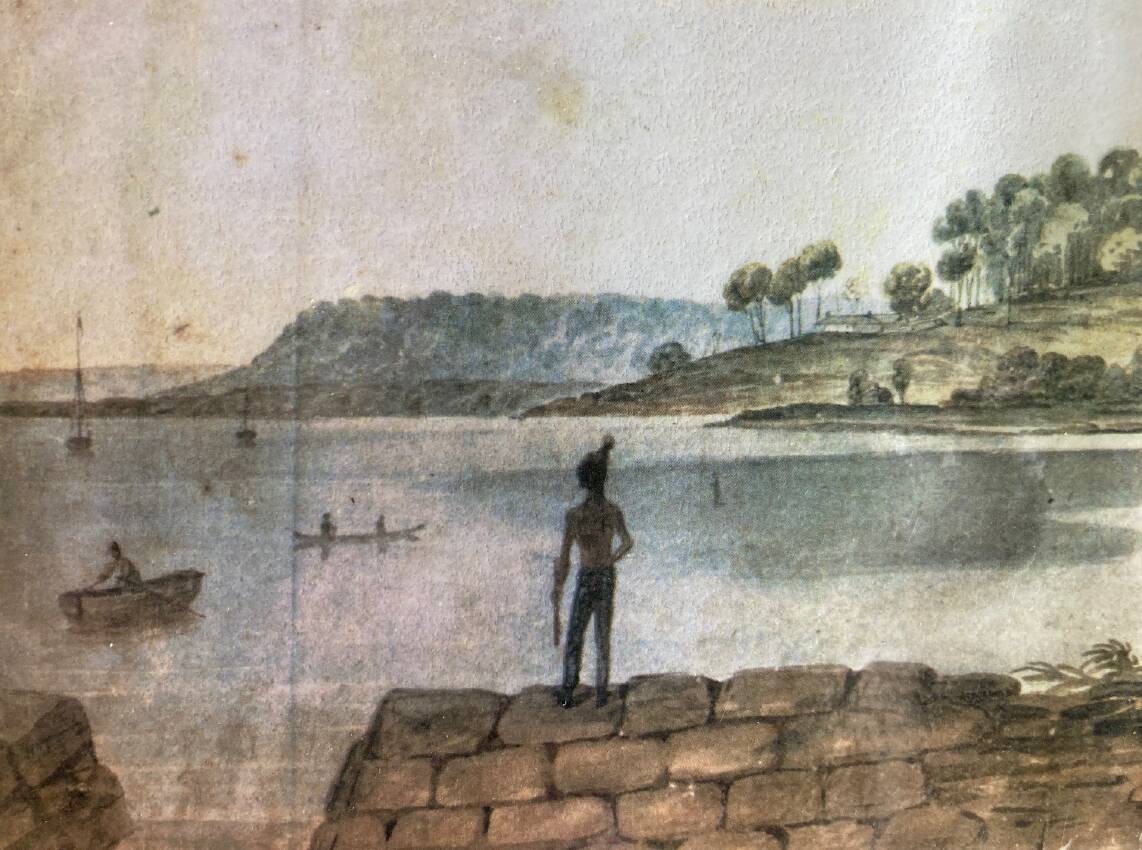
AN unusual view of the northern shore of Port Stephens has re-emerged in an historic artwork.
The rare watercolour print, dating from 1828-29, shows the original Cockrenoyo Point convict boat harbour plus a wide sweep of bay below present Tahlee House, close to the Karuah River mouth. It clearly throws the spotlight on the humble origins of Australia's largest pastoral company, which began on these very shores almost 200 years ago.
The painting is featured in a book, to be published early next year by Tea Gardens historian Janis Winn, outlining an extraordinary colonial success story. The rare artwork shows what appears to be a native standing on the now overlooked, well-formed original stone boat harbour about a kilometre from Tahlee (in the background on a hill amid bush). Mrs Winn said a local resident found the painting by accident in a drawer a few months ago.
Her new book outlines the journey of the Australian Agricultural Company (A.A.Coy) from its start in England in 1824 with a million acre Crown land grant in distant Australia exchanged for one million pounds ($2m). The northern side of the Port Stephens waterway was the chosen site and Robert Dawson became its first agent in NSW. Then in January 1826, ex-soldier Dawson landed in the then wilderness of Port Stephens accompanied by 250 people, 720 sheep, 12 head of cattle and 15 horses. By 1828, the Port Stephens property had a population of almost 600, several buildings, a mill and a sheep flock of about 17,000.
Mrs Winn began to tackle the monumental saga of the A.A.Company three years ago.
"The subject should be two books, really," she tells Weekender. "It's such a big story, tracing the company's origins, its growth and the legacy it's left as one of Australia's most prominent agricultural enterprises.
"I believe it now has more than 500 staff with 485,00 cattle running on 7.7 million hectares, or about 1.2 per cent of Australia."
This same commercial company also rescued early Newcastle from obscurity after its penal colony era ended when it started coal mining here in 1831. After mining ended, the company branched into selling real estate on its former coal mining land, but long before that it had diversified by moving into the Liverpool Plains to further pursue agricultural profits.
In 1833 the company was granted alternative land up here (displacing 23 squatters already occupying prime sites) in lieu of much of the unprofitable Port Stephens land grant that it surrendered. And so, the giant Warrah Estate west of Murrurundi and the even bigger Goonoo Goonoo Estate (313,298 acres), along the left bank for the Peel River, south of Tamworth, came into existence.
But the latest book by Mrs Winn, 86, concentrates on the region she knows best - Port Stephens. A tireless researcher, Mrs Winn's self-published 250-page book is an invaluable, if dense, potted history of the mighty pastoral company, including biographies of its key personnel, numerous photographs and maps. Sadly, there's no index.
Called Chronicles of Carrington, Tahlee and the legacy of the Australian Agricultural Company 200 years, I wish the book had a more catchy title, but it's an accurate summation of its contents.
Mrs Winn previewed her draft copy to Weekender recently, saying those familiar with her previous eight local history books might find few surprises.
"However, I was lucky to find the old diaries of Dawson of later A.A.Coy commissioners at Stroud Court house. It was a rare find," she says.
"And did you knows there were 24 different families who came out with the A.A.Coy's first boss Dawson to Port Stephens in 1826. Well, six members of our local history group here have a connection with them. It's absolutely astounding."
Mrs Winn says the A.A. Company's controversial dismissal of its hard-working chief agent Dawson in 1829 provided a goldmine of information.
"Dawson fought back (and) apart from providing details of a significant early part of the company history, it is the first written record of corporate infighting in Australian history," she says.
Another insight was discovering the company's winemaking venture. The first vintage harvested in Port Stephens began on February 3, 1831, from cuttings taken from Sydney.
Winn also reveals that when Dawson's successor, Arctic explorer Sir Edward Parry, negotiated an exchange of land to obtain the Warrah and Goonoo Goonoo estates, that meant what is now Hawks Nest reverted to the Crown. So, after 1835, the land was suddenly available to lease or buy. Tea Gardens then became the south-east boundary for the A.A.Coy, securing access to the Myall River. By the late 1860s, timber cutters had created a town here called Coweambah.
The A.A.Company developed a host of other towns around Port Stephens, such as Stroud, Booral, Allworth, Karuah (its western boundary) and Gloucester. But some traces of the early pioneering days remain. Take the original A.A.Coy 'port' of Cockrenoyo Point with Tahlee House in the distance as shown in the previously mentioned 1828-29 painting.
Anyone interested in Tahlee homestead itself (the original company HQ) will remember its quaint, second convict boat harbour below. The property, with its old lawn cannon, once employed 12 gardeners when owned and restored by politician R.H.D. White in the 1880s

And yet, Cockrenoyo Point, with its original 1820s boat harbour now in ruins nearby, can still surprise and you don't need to be an archaeologist. And that's the reason Winn's new book is dedicated to her late friend and fellow researcher Stephanie Dee (1950-2023) who once lived at Carrington, the small settlement outside Tahlee. Mrs Winn writes: "She had a wonderful memory for detail (and) after storms she and her grandchildren would go hunting and find lots of pieces of china.
"She walked through the bush and found the first cemetery, the tanning yard and where the early houses and old hospital stood. She drew maps and explained the areas for me, especially Cockrenoyo Point where she found lots of broken china and old bottles as well as the sites of the first boat harbour and brick kilns.
"Stephanie was my silent partner in all the books I have written and now I miss her input."







